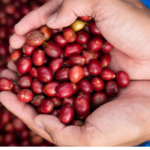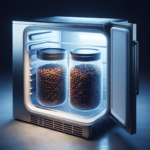Coffee is beloved by many as part of their daily routine. But between opening a new bag of beans to brewing your last cup, have you ever wondered just how long coffee lasts?
Coffee isn’t just a beloved morning ritual for many—it’s a complex beverage that hinges on its freshness. The shelf life of the beans is crucial to taste and quality and understanding it can help you optimize freshness and enjoyment.
In this complete guide, we’ll cover everything you need to know about coffee freshness and preservation. Read on for research-backed insights on how to store coffee properly, signs of stale beans, freeze coffee without compromising taste, and more tips to keep your cup buzzing with flavor.
Roasted coffee has about six months of peak flavor, while specially packaged varieties can last even longer. If you have green beans, they’ll stay fresh for months or years when stored right.
You may not realize it, but how you store your beans makes all the difference; keeping them in airtight containers away from air, moisture, light, and heat preserves their boldness and aroma.
In this comprehensive guide, we’ll break down everything from:
- The shelf life of whole beans vs ground coffee
- Optimal storage methods for maximizing longevity
- How elements like air, light, moisture and heat degrade freshness
- Tips to freeze coffee beans without sacrificing taste
- Signs that indicate coffee has gone stale
- Understanding coffee freshness and shelf life
- The aging process of coffee beans
- Strategies for properly storing coffee beans
- Tips to preserve day-to-day freshness
- And much more…
Key Takeaways
- Coffee beans are freshest within one week after roasting, with whole beans lasting up to six months unopened, but quickly deteriorate in quality once exposed to air, light, heat, and moisture.
- Storing coffee properly involves using airtight containers kept in cool, dark places; avoiding drastic temperature changes; not freezing unless necessary; and considering vacuum sealing for long-term storage.
- Freezing coffee beans can extend their shelf life by preserving freshness and aroma but may also risk condensation and flavor changes if not handled properly.
- Utilize coffee nearing its expiration by brewing methods like cold brew or French press that highlight remaining flavors, blending with fresh beans for complexity or repurposing in recipes and around the home.
- Key strategies include monitoring your coffee’s roast date for optimal freshness within two weeks of purchase, investing in quality containers with one-way valves for storage longevity, handling beans carefully to minimize air exposure.
Typically, roasted coffee beans are considered to be at their best a few days to a week after roasting. This period allows the beans to degas, releasing carbon dioxide and other volatile compounds that can affect the flavor. However, the optimal time to use roasted coffee can vary based on the roast level, bean type, and personal taste preferences.
With confusion around expiration dates, signs of staleness, and confusion around freezing, it can be tricky to nail down an exact shelf life. However, understanding the key factors impacting freshness can empower you to better enjoy coffee’s nuanced flavors day after day.
Did you know that freezing, if done the right way, can help extend their shelf life? It’s true—vacuum sealing and cold storage could be your secret weapon against stale cups.
Understanding what affects coffee longevity helps us keep those flavors intact longer. Whole bean coffee stays fresher than ground variants; aim to use whole beans within 3-4 weeks versus 1-2 weeks for ground blends.
Once opened up from their bags though, aim to enjoy those aromatic beans within a week to catch them at their best!
Understanding Coffee Freshness and Shelf Life
Before diving into specifics on timelines, it helps to level-set on what coffee freshness actually means and why it matters.
What makes coffee taste “fresh”? Freshness comes down to aromatic compounds and flavor oils retained inside the bean. Freshness influences the entire coffee experience – from the aromatic compounds released into headspace to the vibrant, complex flavors extracted during brewing. So what does “fresh” coffee look and taste like?
Freshly roasted whole beans have a slightly oil sheen and dark, matte color. The aromas are vibrant and complex, often with fruity, floral, or sweet notes. The tastes maintain clarity and brightness, with crisp acidity and full, rich mouthfeel. As coffee stales, the oils turn dull, aromas flatten, and the cup loses sweetness while bitterness increases. So the key markers of freshness are aromatic vibrance and taste clarity.
What accounts for coffee’s declining freshness and shrinking shelf life after roasting? Key factors are oxidation, off-gassing of CO2, and moisture loss. Oils degrade, aroma dulls, and beans dry out over time. How rapidly quality declines depends largely on environmental factors like air, light, heat, and humidity that beans are exposed to during storage.
Coffee freshness is vital for enjoying a rich and flavorful cup of coffee. Understanding the signs and factors of degradation, as well as the aging process of coffee beans, is crucial in preserving the quality and taste of your brew.

Does Coffee Go Bad? Signs and Factors of Degradation
Absolutely, coffee can go bad over time. Beans that are past their prime start to lose their robust flavors and unique aroma, leading to a less satisfying cup. The freshness of whole bean coffee outlasts its ground counterpart as it’s less exposed to the elements that accelerate staleness.
However, without proper storage, even these beans will deteriorate.
Several signs indicate your coffee may have spoiled. If there is a noticeable lack of scent or if the once rich and vibrant smell has faded, this is often an indicator of stale coffee.
Beans that appear oily or dull and taste flat or have taken on an unpleasant bitterness also suggest degradation in quality. Furthermore, exposure to air, light, heat, and moisture hastens this process — enemies of preserving those sought-after flavors.
To maintain peak freshness for as long as possible requires vigilance against these external factors. Properly sealed containers away from direct sunlight and high temperatures help prolong the life of your favorite brews—whether they’re freshly roasted beans or pre-ground selections waiting for their turn in the grinder.
Keeping them dry will also ward off any mold growth which not only ruins the flavor but can also pose health risks. Remembering these simple steps helps ensure each cup you pour preserves the essence of its origin for a delicious experience every time.
How long is ground coffee good for after roasting?
Ground coffee is best when used within two weeks after roasting. While it can last up to a month, its freshness and flavor diminish over time. For optimal taste, store it in an airtight container away from light and heat.
The Aging Process of Coffee Beans
Knowing the signs of degradation in coffee is just one piece of the puzzle; it’s equally important to understand how coffee beans age over time. Once roasted, coffee enters a state of constant change.
Roasting triggers chemical reactions that enhance flavor and aroma, but this also starts the clock on freshness. The shelf life for roasted coffee beans hovers around six months before they begin to lose their zest —even if never opened.
As soon as you take freshly roasted coffee home, degassing occurs—a natural process where gases, primarily carbon dioxide that built up during roasting, escape from the beans. This is crucial for developing the full profile of flavors and maintaining quality but also signifies an inevitable march toward staleness.
Aged beans eventually dull in taste and fragrance as oxidation takes its toll, sapping once-vibrant notes and leaving behind a flat cup lacking complexity.
For raw or green beans, time plays a different role. These unroasted gems can hold their potential for years under optimal conditions away from light, moisture, and extreme temperatures.
A clear understanding of these dynamics ensures better storage decisions to preserve those much-sought-after fresh coffee aromas and tastes that make each sip a rich experience.
How Long Does Coffee Last?

Coffee has different shelf lives depending on its form — whole beans, ground, pods, brewed, or instant. Understanding the lifespan of each type and implementing proper storage techniques is essential for maintaining
Lifespan of Coffee in Various Forms: Whole Beans, Ground, Pods, Brewed, and Instant
Examining the lifespan of coffee in its various forms reveals significant differences in how long you can expect your coffee to retain its optimal flavor and freshness. Whether you prefer whole beans, ground coffee, pods, a quick cup of instant, or fresh-brewed coffee, understanding the shelf life can help you enjoy your caffeine fix at its best.
| Coffee Form | Unopened Shelf Life | Opened Shelf Life |
|---|---|---|
| Whole Beans | Up to 6 months | 1-3 weeks in airtight container at room temperature |
| Ground Coffee | 1-3 months | 1-2 weeks for optimal flavor |
| Coffee Pods | 8-12 months | Use immediately after opening for best taste |
| Brewed Coffee | N/A | Consume within a few hours |
| Instant Coffee | Up to 2 years | 2-3 weeks once opened |
For whole beans, preserving their freshness involves storing them at room temperature in an airtight container once opened. Ground coffee has a shorter window of peak freshness post-grinding, necessitating quick usage. Coffee pods are designed for single-use and should be enjoyed soon after opening to prevent loss of flavor.
Brewed coffee is best consumed shortly after preparation to experience its full taste profile. With instant coffee, the convenience comes with a longer shelf life, but once the seal is broken, consume within a few weeks for best quality.
Strategies for Properly Storing Coffee Beans
Properly storing your coffee beans is essential to maintaining their freshness and flavor. Here are some effective strategies for storing coffee beans to preserve their quality:
- Use an airtight container: Transfer the coffee beans from their original packaging into an airtight container to protect them from exposure to air, moisture, and light.
- Store in a cool, dark place: Keep the sealed container of coffee beans in a cool and dark location, such as a pantry or cupboard, away from direct sunlight and heat sources.
- Avoid frequent temperature changes: Fluctuations in temperature can cause condensation inside the storage container, affecting the quality of the coffee beans. Keep the storage location consistent.
- Do not freeze unless necessary: While freezing can extend the shelf life of coffee beans, it’s best to avoid frequent freezing and thawing as it can impact the flavor and aroma of the beans.
- Purchase smaller quantities: Buy smaller batches of fresh coffee more frequently, especially if you consume it within a week or two, to minimize prolonged exposure to air after opening.
- Monitor roast dates: When purchasing coffee, pay attention to the roast date and aim to consume it within 1-2 weeks after roasting for optimal freshness.
- Consider vacuum sealing: If you have excess roasted coffee beans that you won’t use immediately, consider vacuum-sealing them to preserve their freshness for an extended period.
- Use a dedicated grinder: If possible, grind your whole coffee beans just before brewing to retain maximum flavor and aroma.
Tips to Preserve Coffee Freshness
You’ve just brought home a new bag of specialty beans – now what? Here are our top tips for protecting coffee quality once you open the bag:
Optimal Packaging for Longevity
Choose storage bags and containers that block key threats to freshness:
Oxygen: One-way valve bags or airtight tins prevent oxygen from accelerating staleness
Light: Opaque containers prevent light from initiating oxidation
Moisture: Well-sealed vessels prevent moisture transferring in humid environments
Heat: Store coffee away from heat sources like ovens or dishwashers
Glass jars make great containers when topped with an airtight lid. Some coffee bags also come with zipper seals or one-way degassing valves to remove air.
Optimal Packaging for Longevity
Invest in airtight storage canisters to preserve the freshness of your coffee beans for an extended period. Opt for packaging with multiple layers, as this helps maintain quality and flavor, making it an excellent choice for bulk or subscription purchases.
Additionally, select storage containers equipped with one-way valve seals to ensure that your coffee remains at its best for months or even years.
When stored correctly, coffee beans keep their freshness remarkably well. Airtight containers serve as one of the most effective methods available for maintaining the longevity of your coffee beans while enhancing their overall shelf life to ensure every cup is just as delightful as the last.
Protecting Coffee from Oxygen, Light, Moisture, and Heat
To maintain optimal coffee freshness, it’s crucial to safeguard your beans from the detrimental effects of oxygen, light, moisture, and heat. Here are some effective strategies to protect your precious coffee:
- Airtight Containers: Store your coffee in airtight containers to shield it from exposure to oxygen, which can cause flavor degradation over time.
- Dark Storage: Keep your coffee beans away from direct sunlight or any sources of bright light that can accelerate the deterioration of their quality.
- Low Humidity: Ensure that the storage area for your coffee is dry, as excess moisture can compromise the flavor and aroma of the beans.
- Cool Temperature: Store your coffee in a cool environment to prevent heat from speeding up the aging process and altering its taste profile.
- Repackaging Opened Bags: If you’ve opened a bag of coffee beans, consider transferring them into an airtight container to minimize their exposure to oxygen and maintain their freshness.
- Avoiding Refrigeration: Refrain from storing coffee in the refrigerator as it can introduce moisture and odors that affect the flavor and aroma of the beans.
- Vacuum Sealing: Consider vacuum sealing your coffee for long-term storage to eliminate air and preserve its flavors for an extended period.
- Proper Handling: Handle your coffee carefully by ensuring that lids are tightly sealed after each use to prevent oxidation.
- Quality Packaging: Select high-quality packaging designed specifically for preserving the freshness of coffee beans by protecting them from external elements.
- Limited Air Exposure: Minimize frequent opening of containers or bags containing coffee beans as prolonged exposure to air can lead to flavor deterioration over time.
Utilizing Coffee Nearing Its Expiration Date
When your coffee is nearing its expiration date, here are essential tips to ensure you still enjoy a flavorful cup:
- Opt for brewing methods that accentuate the remaining flavors: methods such as cold brewing or using a French press can bring out the best in aging coffee.
- Incorporate your expiring coffee into recipes: use it in baking, cooking, or even to make coffee-flavored desserts to avoid wastage and add a depth of flavor.
- Blend expiring coffee with fresh beans: this can add complexity and depth to your brew while ensuring that none of the beans go to waste.
- Experiment with different brewing ratios: adjusting the amount of coffee grounds used and water ratio can help bring out unexpected flavors from aging beans.
- Keep track of taste changes: monitor how the flavor evolves as your coffee ages; understanding these changes can lead to surprising but enjoyable results.
- Create your own custom blend by mixing various types of expiring coffees together or even incorporating different roast levels for an enhanced and unique taste experience.
- Harness the grounds for alternative uses: repurpose them as a natural deodorizer or exfoliator, providing an eco-friendly solution for extending their utility.
The Bottom Line
After reviewing all factors impacting shelf life, what’s the final verdict on longevity? Here are the key freshness timelines to remember:
1 Month After Opening: Peak flavor period for whole beans; use ground coffee within 2 weeks
3 Months After Opening: Flavor fade becomes noticeable but coffee still usable if well-stored
6 Months After Opening: Decline in oils and aromatic compounds; better for baking or cold brew
1 Year After Roasting: Greatly diminished flavor when reaching this mark; discard beans
The countdown clock starts as soon as roasting finishes. So no matter how you store beans, make sure you use them up within 12 months for best results!
Follow these coffee freshness commandments, and you’ll be rewarded with better taste and aroma in every cup of joy!
Final Thoughts on Understanding Coffee Freshness and Shelf Life
In conclusion, mastering the art of coffee freshness is within your reach. By implementing proper storage methods and paying attention to the roast date, you can savor the rich flavor and enticing aroma of your coffee beans.
These practical strategies are not only easy to apply but also incredibly efficient in maintaining coffee quality over time. Understanding the significance of these practices will lead to a heightened appreciation for every cup of coffee you brew.
As you embark on this journey towards maximizing your coffee enjoyment, remember: fresh beans make all the difference in your daily indulgence.






